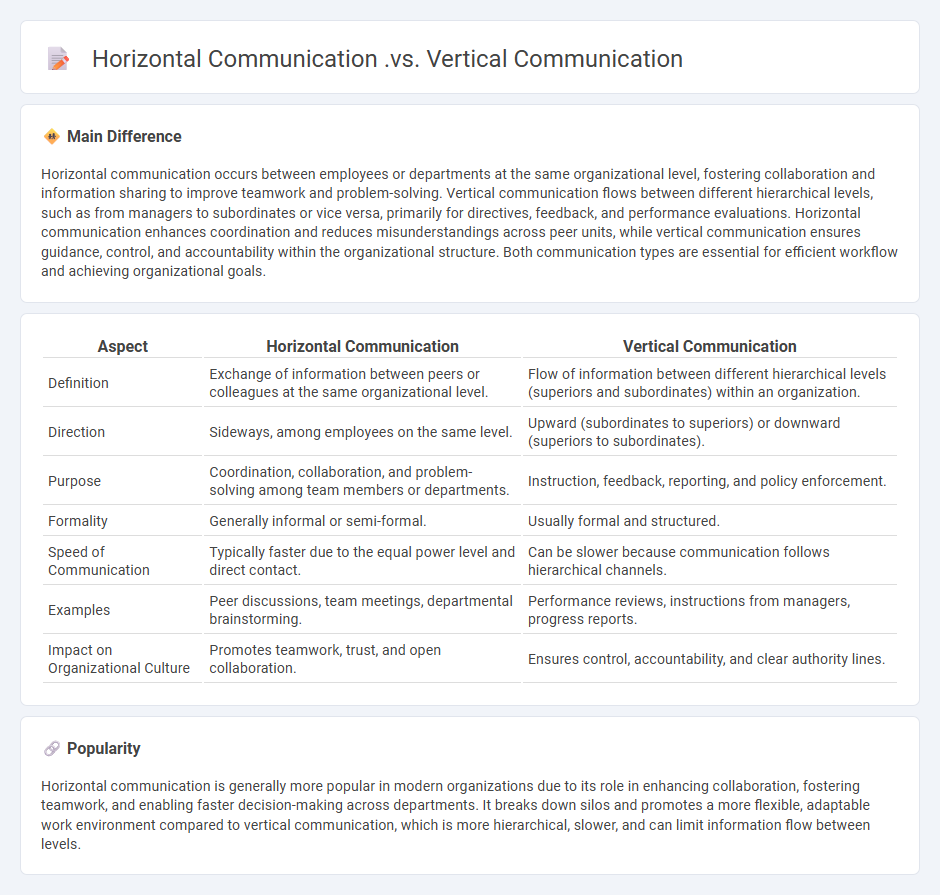
Horizontal communication facilitates information exchange between employees at the same organizational level, enhancing collaboration and teamwork across departments. Vertical communication occurs between different hierarchical levels, allowing directives, feedback, and performance information to flow between supervisors and subordinates. Discover how these communication types impact organizational efficiency and culture.
Main Difference
Horizontal communication occurs between employees or departments at the same organizational level, fostering collaboration and information sharing to improve teamwork and problem-solving. Vertical communication flows between different hierarchical levels, such as from managers to subordinates or vice versa, primarily for directives, feedback, and performance evaluations. Horizontal communication enhances coordination and reduces misunderstandings across peer units, while vertical communication ensures guidance, control, and accountability within the organizational structure. Both communication types are essential for efficient workflow and achieving organizational goals.
Connection
Horizontal communication facilitates information flow between peers at the same organizational level, fostering collaboration and coordination. Vertical communication connects different hierarchical levels, enabling directives from management to reach employees and feedback to travel upward. Together, these communication channels ensure a cohesive, efficient exchange of information that supports decision-making and organizational alignment.
Comparison Table
| Aspect | Horizontal Communication | Vertical Communication |
|---|---|---|
| Definition | Exchange of information between peers or colleagues at the same organizational level. | Flow of information between different hierarchical levels (superiors and subordinates) within an organization. |
| Direction | Sideways, among employees on the same level. | Upward (subordinates to superiors) or downward (superiors to subordinates). |
| Purpose | Coordination, collaboration, and problem-solving among team members or departments. | Instruction, feedback, reporting, and policy enforcement. |
| Formality | Generally informal or semi-formal. | Usually formal and structured. |
| Speed of Communication | Typically faster due to the equal power level and direct contact. | Can be slower because communication follows hierarchical channels. |
| Examples | Peer discussions, team meetings, departmental brainstorming. | Performance reviews, instructions from managers, progress reports. |
| Impact on Organizational Culture | Promotes teamwork, trust, and open collaboration. | Ensures control, accountability, and clear authority lines. |
Communication Flow
Communication flow refers to the directional movement of information between individuals or groups within an organization. It can be classified into upward, downward, horizontal, or diagonal flows, each facilitating specific types of interaction and information exchange. Efficient communication flow ensures clarity, reduces misunderstandings, and enhances decision-making processes. Organizations with well-structured communication flows typically experience improved collaboration and overall productivity.
Hierarchical Structure
Hierarchical structure in communication defines the formal organization of information flow within an institution, establishing clear lines of authority and responsibility. It facilitates efficient decision-making by delineating roles from top management to operational levels, ensuring messages pass through predefined channels. This structure supports clarity and accountability, reducing miscommunication in corporate or military environments. Studies in organizational behavior highlight that well-implemented hierarchical communication enhances synchronization and productivity across departments.
Information Sharing
Information sharing in communication involves the effective exchange of data, ideas, and insights among individuals or groups to enhance understanding and decision-making. It employs various channels such as verbal conversations, written documents, and digital platforms to ensure accurate and timely dissemination. Effective information sharing reduces misunderstandings, fosters collaboration, and drives organizational success. Technologies like cloud computing and collaborative software have transformed traditional methods by enabling real-time sharing and integration of information.
Collaboration Efficiency
Effective communication significantly enhances collaboration efficiency by ensuring clear exchange of ideas and reducing misunderstandings. Real-time communication tools like Slack and Microsoft Teams improve team responsiveness and project coordination. Transparent information sharing fosters trust and alignment among team members, accelerating decision-making processes. Streamlined communication workflows reduce delays and promote a productive collaborative environment.
Decision-making Authority
Decision-making authority in communication refers to the power to determine how information is shared within an organization or group. It influences the flow of messages, the channels used, and the content distributed to ensure clarity and effectiveness. Effective decision-making authority enhances coordination, reduces misunderstandings, and supports organizational goals. Research shows that centralized communication authority often leads to faster decisions, while decentralized models improve flexibility and employee engagement.
Source and External Links
Vertical, Horizontal & Diagonal Communication - A Complete Guide - Explains the differences in purpose, information flow, and medium between horizontal and vertical communication.
Horizontal Communication | Definition & Examples - Distinguishes between horizontal communication, which occurs at the same level, and vertical communication, which happens between different levels.
Horizontal vs. Vertical Communication - Highlights the advantages and disadvantages of both types of communication, including their roles in organizational functioning.
FAQs
What is horizontal communication?
Horizontal communication is the exchange of information between employees or departments at the same organizational level to coordinate tasks, share ideas, and resolve issues.
What is vertical communication?
Vertical communication is the exchange of information between different hierarchical levels within an organization, typically involving supervisors and subordinates.
How does horizontal communication differ from vertical communication?
Horizontal communication occurs between peers or colleagues at the same organizational level, facilitating collaboration and coordination, while vertical communication flows between different hierarchical levels, involving directives, feedback, and reporting.
What are the main advantages of horizontal communication?
Horizontal communication enhances collaboration, speeds decision-making, improves information flow across departments, reduces misunderstandings, and fosters a cohesive organizational culture.
What are the main advantages of vertical communication?
Vertical communication enhances organizational clarity by ensuring clear direction and feedback flow between management and staff, improves decision-making speed by facilitating direct information exchange, and strengthens accountability through defined communication channels.
What challenges can arise in horizontal communication?
Challenges in horizontal communication include misunderstandings due to lack of clarity, information overload, conflicting priorities among peers, insufficient feedback, and barriers caused by organizational silos or lack of trust.
How can organizations balance horizontal and vertical communication effectively?
Organizations can balance horizontal and vertical communication effectively by establishing clear communication channels, promoting a culture of openness, implementing collaborative tools for peer-to-peer interaction, ensuring regular feedback loops between management and employees, and aligning communication goals with organizational objectives.
 calledges.com
calledges.com